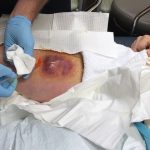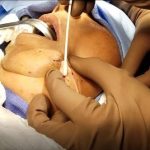Remove blackheads on the face
Please scroll down to watch the video.👇👇
Removing blackheads on the face requires proper skin care techniques to unclog pores safely, avoid skin damage, and reduce recurrence. Here’s a detailed step-by-step guide, along with clinical references and dermatologist-approved tips.
🟤 What Are Blackheads?
Blackheads are a type of open comedone, formed when dead skin cells and sebum (oil) clog hair follicles and become exposed to air, causing the material to oxidize and turn black.
Common areas:
-
Nose
-
Chin
-
Forehead
-
Cheeks
📖 Reference: American Academy of Dermatology (AAD)
✅ How to Safely Remove Blackheads on the Face
1. Gentle Cleansing
-
Wash your face twice a day with a mild salicylic acid cleanser to help dissolve oil and exfoliate.
🧴 Recommended: CeraVe Renewing SA Cleanser or La Roche-Posay Effaclar Medicated Gel Cleanser
2. Steam or Warm Compress
-
Apply a warm towel or use a facial steamer for 5–10 minutes to open pores.
-
Helps soften the blackhead plug for easier removal
-
📖 Cleveland Clinic – Blackhead Prevention
3. Use a Chemical Exfoliant (2–3x a week)
-
Use products with:
-
Salicylic Acid (BHA) – penetrates into pores to break up clogs
-
Glycolic Acid (AHA) – helps with surface exfoliation
-
Retinoids (adapalene) – reduce blackheads by normalizing skin cell turnover
-
📖 Reference: Mayo Clinic – Acne Treatments
4. Extraction (Optional)
If needed, perform manual extraction with proper tools:
How to Do It Safely:
-
Disinfect a comedone extractor tool
-
After steaming, gently press the loop over the blackhead
-
If it doesn’t come out easily, stop
-
Wipe the area with an antiseptic after
⚠️ Avoid pinching with nails – this can cause scarring and infections
📖 Journal of Clinical and Aesthetic Dermatology – Comedone Extraction
5. Use Clay or Charcoal Masks
-
Once a week, apply a clay mask (like kaolin or bentonite) to absorb oil and reduce pore congestion.
-
Charcoal masks can help draw out impurities from pores.
🚫 What to Avoid
-
Harsh scrubbing (can irritate and worsen blackheads)
-
Pore strips (temporary effect, can damage skin)
-
Over-cleansing (can dry out and irritate your skin)
🩺 When to See a Dermatologist
-
Persistent blackheads that don’t respond to home care
-
If blackheads are widespread or inflamed
-
If you’re developing scarring or cystic acne
A dermatologist can offer:
-
Prescription-strength retinoids (e.g., tretinoin)
-
In-office chemical peels
-
Professional comedone extraction
-
Laser and light therapy
🧴 Product Examples (Non-Comedogenic & Dermatologist Recommended)
-
Cleanser: Neutrogena Oil-Free Acne Wash
-
Treatment: Differin Gel (Adapalene 0.1%)
-
Exfoliant: Paula’s Choice BHA Liquid Exfoliant
Removing blackheads safely and effectively involves a combination of proper skincare practices, the use of appropriate products, and, in some cases, professional treatments. Here’s a comprehensive guide based on dermatologist recommendations:
🟤 What Are Blackheads?
Blackheads are a type of acne known as open comedones. They form when hair follicles become clogged with a combination of sebum (oil) and dead skin cells. Unlike whiteheads, blackheads have open surfaces, which allows oxidation to occur, giving them their characteristic dark appearance.
🧼 Step-by-Step Guide to Removing Blackheads
1. Cleanse Your Face Twice Daily
-
Use a gentle, non-comedogenic cleanser to remove excess oil and impurities.
-
Avoid harsh scrubbing, which can irritate the skin and exacerbate acne.
-
Consistent cleansing helps prevent the accumulation of debris in pores.
2. Incorporate Salicylic Acid
-
Salicylic acid is a beta-hydroxy acid (BHA) that penetrates pores to dissolve sebum and exfoliate dead skin cells.
-
Look for over-the-counter products containing 0.5% to 2% salicylic acid.
3. Use Retinoids
-
Topical retinoids, such as adapalene, promote cell turnover and prevent the formation of clogged pores.
-
They are particularly effective for persistent blackheads and can be found in products like Differin Gel.
4. Apply Clay Masks Weekly
-
Clay masks, containing ingredients like kaolin or bentonite, absorb excess oil and help draw out impurities from pores.
-
Use once or twice a week to maintain clear skin.
5. Avoid Pore Strips and Aggressive Extraction
-
While pore strips may provide immediate results, they can irritate the skin and potentially enlarge pores over time.
-
Manual extraction should be performed by professionals to minimize the risk of scarring and infection.
🩺 When to Seek Professional Help
If over-the-counter treatments are ineffective, or if blackheads are widespread and persistent, consult a dermatologist. Professional options include:
-
Chemical Peels: Utilize acids to exfoliate the skin and clear clogged pores.
-
Microdermabrasion: A procedure that exfoliates the skin’s surface, improving texture and clarity.
-
Prescription Medications: Stronger topical or oral treatments may be prescribed for severe cases.
🛡️ Preventive Measures
-
Use Non-Comedogenic Products: Ensure skincare and makeup products are labeled “non-comedogenic” to prevent pore clogging.
-
Maintain a Healthy Diet: Some studies suggest a low-glycemic diet may reduce acne.
-
Manage Stress: Stress can exacerbate acne; incorporate stress-reducing activities into your routine.
-


